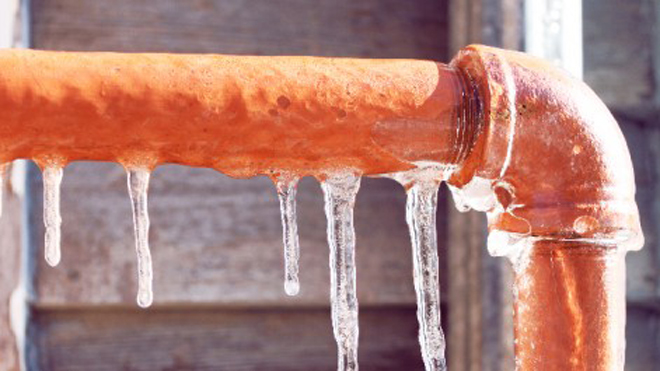Essential Tips to Protect Against Frozen Plumbing in Cold Weather
Essential Tips to Protect Against Frozen Plumbing in Cold Weather
Blog Article
Presented here in the next paragraphs you will find a good deal of reliable insight in regards to Prevent Frozen Pipes .

Winter can damage your pipes, specifically by freezing pipes. Here's how to prevent it from occurring and what to do if it does.
Intro
As temperatures decline, the threat of frozen pipelines boosts, possibly resulting in pricey repair work and water damages. Comprehending just how to prevent frozen pipelines is vital for homeowners in chilly environments.
Understanding Frozen Pipelines
What triggers pipes to freeze?
Pipes freeze when subjected to temperatures below 32 ° F (0 ° C) for prolonged periods. As water inside the pipelines freezes, it broadens, putting pressure on the pipe wall surfaces and possibly triggering them to rupture.
Threats and damages
Icy pipelines can result in water supply interruptions, residential or commercial property damages, and pricey repairs. Burst pipes can flood homes and cause comprehensive structural damage.
Indications of Frozen Water Lines
Determining frozen pipes early can prevent them from bursting.
How to recognize frozen pipelines
Seek decreased water flow from faucets, unusual odors or sounds from pipes, and visible frost on exposed pipes.
Avoidance Tips
Shielding vulnerable pipelines
Wrap pipes in insulation sleeves or utilize warmth tape to secure them from freezing temperature levels. Focus on pipes in unheated or exterior locations of the home.
Heating methods
Maintain interior rooms adequately heated up, especially locations with pipes. Open closet doors to enable warm air to flow around pipelines under sinks.
Safeguarding Exterior Pipes
Garden hose pipes and exterior faucets
Disconnect and drain pipes yard hoses before wintertime. Mount frost-proof spigots or cover outside taps with shielded caps.
What to Do If Your Pipelines Freeze
Immediate activities to take
If you suspect frozen pipes, maintain taps open to eliminate stress as the ice thaws. Make use of a hairdryer or towels taken in warm water to thaw pipes slowly.
Long-Term Solutions
Structural changes
Take into consideration rerouting pipelines away from exterior wall surfaces or unheated areas. Add added insulation to attic rooms, basements, and crawl spaces.
Updating insulation
Purchase top notch insulation for pipes, attic rooms, and walls. Proper insulation assists maintain regular temperatures and reduces the danger of frozen pipes.
Verdict
Stopping frozen pipes calls for proactive procedures and fast feedbacks. By understanding the reasons, indicators, and preventive measures, house owners can secure their pipes during winter.
5 Ways to Prevent Frozen Pipes
Drain Outdoor Faucets and Disconnect Hoses
First, close the shut-off valve that controls the flow of water in the pipe to your outdoor faucet. Then, head outside to disconnect and drain your hose and open the outdoor faucet to allow the water to completely drain out of the line. Turn off the faucet when done. Finally, head back to the shut-off valve and drain the remaining water inside the pipe into a bucket or container. Additionally, if you have a home irrigation system, you should consider hiring an expert to clear the system of water each year.
Insulate Pipes
One of the best and most cost-effective methods for preventing frozen water pipes is to wrap your pipes with insulation. This is especially important for areas in your home that aren’t exposed to heat, such as an attic. We suggest using foam sleeves, which can typically be found at your local hardware store.
Keep Heat Running at 65
Your pipes are located inside your walls, and the temperature there is much colder than the rest of the house. To prevent your pipes from freezing, The Insurance Information Institute suggests that you keep your home heated to at least 65 degrees, even when traveling. You may want to invest in smart devices that can keep an eye on the temperature in your home while you’re away.
Leave Water Dripping
Moving water — even a small trickle — can prevent ice from forming inside your pipes. When freezing temps are imminent, start a drip of water from all faucets that serve exposed pipes. Leaving a few faucets running will also help relieve pressure inside the pipes and help prevent a rupture if the water inside freezes.
Open Cupboard Doors
Warm your kitchen and bathroom pipes by opening cupboards and vanities. You should also leave your interior doors ajar to help warm air circulate evenly throughout your home.

I stumbled upon that post about How to prepare your home plumbing for winter weather when doing a lookup on the internet. Please take a moment to promote this article if you enjoyed reading it. Bless you for being here. Kindly come visit our website back soon.
Book Today Report this page